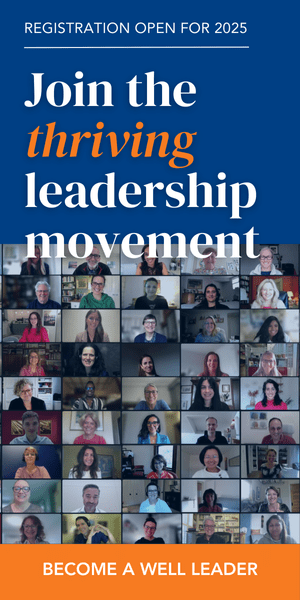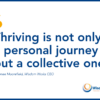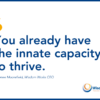 In my work to coach, advise, and support the conscious evolution of leadership with all walks of leaders over the past thirty years, I’ve witnessed a significant shift underway. Thriving has finally found its footing as essential to leadership effectiveness. More and more leaders view their role as actively empowering thriving as a taproot from which inspired purpose, meaningful connections, and positive impact can grow for people and whole systems.
In my work to coach, advise, and support the conscious evolution of leadership with all walks of leaders over the past thirty years, I’ve witnessed a significant shift underway. Thriving has finally found its footing as essential to leadership effectiveness. More and more leaders view their role as actively empowering thriving as a taproot from which inspired purpose, meaningful connections, and positive impact can grow for people and whole systems.
Some say this motivation is even more front-and-center for Millennials, that generation of people now approximately 19-36 years old, who are more apt to value work as a calling, rather than a job. Millennials seem to be asking the deeper questions of wellbeing at younger ages than ever before: What do I want for my life? What are my dreams? How can I best contribute to something greater than myself?
Yet, what I know for certain is: reflecting on thriving is quite different than living and leading it. So, I was delighted to speak with Lauren Kiraly, Operational Director for TEDxAmsterdamWomen, an expert at leadership coaching and facilitating workshops worldwide to help young professionals cultivate their innate potential to thrive. She explained that although Millennials are contemplating the right wellbeing questions, they often experience the highest rates of burnout—a problem individually and a challenge for everyone who relies on this generation to better our organizations, our communities, and our planet.
Here’s what else Lauren shared with me:
Renee Moorefield: Why are you interested in burnout and Millennials?
Lauren Kiraly: Because, there is a fine line between burnout and human potential.
Human potential is my passion—the possibilities we’re each capable of accomplishing—but the more I understand what potential is and how to access it, the more I realize that the very things we need to reach our potential are often the greatest causes of stress (and a precursor for burnout), and therefore the very things that are standing in our way. For example, what we eat can either nourish and heal us or deplete us, like when we rely on excessive caffeine to carry us through the day.
In my work, I design programs and systems to help individuals and organizations reach their potential, with a focus on Millennials as the future of the workforce. And what I see is: a group that is incredibly passionate and committed to making an impact in their work yet has the highest rates of burnout. So, here is a group of people that may hold the greatest potential for the workforce globally—and at a time in their lives when they themselves are primed to actualize their potential—but many are burning out before 30!
Renee Moorefield: How widespread is the problem of burnout for Millennials?
Lauren Kiraly: Whew, quite! Burnout impacts over half of the workforce today. According to the 2016 Staples Business Advantage Workplace Index, it affects an estimated 40% of employees and an upwards of 95% of businesses worldwide.
And the real kicker when it comes to Millennials is that burnout impacts women more than men. Take into consideration that half of the over 83 million Millennials in the current United States workforce alone are women. So, while we’re strategically investing organizational resources to create a more gender-diverse workforce, burnout is adversely impacting those efforts.
Clearly, if burnout is unaddressed, the implication is not only an unhealthy workforce but an unhealthy world.
Renee Moorefield: How is burnout showing itself in the lives and work of Millennials, versus other generations?
Lauren Kiraly: Compared to other generations, today’s relationship to and nature of work has shifted. Millennials entered the workplace attached to a technology device, increasing the reach of work into their personal lives. Today is a 24/7-on culture where work and life are integrated and the work/life boundaries for Millennials are blurred. Compound that with the fact that stress is cumulative over time. To make matters worse, Millennials unfortunately have been shown to be the group with the most underdeveloped stress-management practices.
Renee Moorefield: What do you mean that stress is cumulative?
Lauren Kiraly: Because of the effects of chronic stress, the body quite literally begins burning out! We’re seeing health trends within the Millennial population that support this, such as increasing rates of infertility, colorectal cancer and diabetes, and rising cases of anxiety, ADHD, and depression.
It’s important to remember that burnout presents itself in multiple ways and in phases. Overall, it manifests as a system-wide impact, from physical and emotional to cognitive and behavioral.
Burnout has also been shown to distinctly change the brain’s anatomy and functioning, creating a unique signature similar to people who have experienced significant trauma with impact to one’s memory, creativity, problem solving, emotional regulation, and attention.
The adrenals take a big hit as well. Not to get too technical, the adrenals are responsible for the release of the stress hormone cortisol which is an “energy mobilization hormone.” When we experience stress, the body releases a cortisol burst—our cell metabolism temporarily increases, as does our blood pressure, blood sugar, and blood fat levels. When the threat has subsided, the body returns to homeostasis. But when we’re stressed for prolonged periods of time, the body assumes it is under constant threat, and this prevents it from returning to “normal.” As a result, our blood pressure and blood sugar levels stay elevated (precursors for coronary heart disease and diabetes), and the extended higher-than-normal cortisol levels fatigue our adrenals, resulting in low hormone production. And because our body is diverting all its resources to handle the stress, it begins ignoring basic functions, like digestion, further depleting our body’s nutrients.
As you can see, this is a vicious cycle …
Renee Moorefield: What do you believe must be done by organizations to create work and workplaces where millennials thrive, rather than burn out?
Lauren Kiraly: Fortunately, the concept of work is changing, including when and where work is done. You see an example of this with the emergence of flexible work environments which aim to enhance productivity and maximize the potential of individuals and teams. Work flexibility can be healthy because it allows employees to naturally integrate work into their life and manage tasks against their biorhythms and personal peak energy levels. It’s a concept Millennials have really latched on to.
However, most companies are still in what I’d call a “letting go” phase of old workplace norms, placing an extra, unintentional burden on employees to toggle between the ‘old’ and ‘new’. It’s a big change: as we adapt to a more flexible work style, the organization’s responsibility must shift from monitoring adherence to a set work schedule to helping employees find ways to fluidly manage and express their best work.
And this calls for a different leadership style, one that models thriving. I’ve always loved the quote, so applicable here: “You can’t sell what you don’t have in stock.” If an organization wants its employees to thrive at work, it must first look to its leaders who set the tone of the culture: What behaviors are they modeling? Do they skip lunch to attend meetings? Take meetings while on vacation? Blast emails until 2am?
At the end of the day, organizations must realize that preventing burnout requires a solution at both individual and collective levels; a “one-sized, fits all” approach won’t work. And there is no silver bullet. Instead, fostering an organization where Millennials—and all generations—thrive requires a system-wide commitment for the company and each of its employees, a continuous investment of time and energy.
Renee Moorefield: What do you believe Millennials must do personally to thrive, rather than burn out?
Lauren Kiraly: Most simply? Deepen their relationship with themselves. Any solid relationship is based in trust and communication.
Speaking as a Millennial personally, I’ve learned this means trusting in yourself and listening to yourself. In today’s fast-paced world, it’s easy to mentally override or even turn off our internal indicators, moving through the day on autopilot. To pivot from burnout to thriving requires that we shift to a state of conscious awareness. Practices like meditation, yoga, and breathing techniques, for example, help because they lower cortisol levels, elevate our awareness of thought patterns, and create a space between our thoughts and often automatic responses that empower us to choose what best serves us in that moment.
It sounds simplistic, because it is. Then again, the simplest things are often the hardest to do.
To learn more about Lauren Kiraly: https://www.linkedin.com/in/lauren-kiraly-5a827222/
To access Wisdom Works’ new leadership assessment, Be Well Lead Well® Pulse, which helps leaders examine and uplevel their capacities for thriving and resilience, drop me an email at renee@wisdom-works.com.
READ MORE
- 10 Shifts Driving a New ‘Thrive’ Revolution at Work
- Can Wellbeing Drive Value for Business & Society?
- Don’t Wait Until Later—Thriving Is Your Best Strategy
- Three Illusions that May Prevent Your Deepest Wellbeing
- 3 Strategies to Unleash Your Potential As Leader And Whole Human Being
Image: shutterstock148116878






